The Samsung Galaxy S10+ Snapdragon & Exynos Review: Almost Perfect, Yet So Flawed
by Andrei Frumusanu on March 29, 2019 9:00 AM ESTInference Performance: APIs, Where Art Thou?
Having covered the new CPU complexes of both new Exynos and Snapdragon SoCs, up next is the new generation neural processing engines in each chip.
The Snapdragon 855 brings big performance improvements to the table thanks to a doubling of the HVX units inside the Hexagon 690 DSP. The HVX units in the last two generations of Snapdragon chips were the IP blocks who took the brunt of new integer neural network inferencing work, an area the IP is specifically adept at.
The new tensor accelerator inside of the Hexagon 690 was shown off by Qualcomm at the preview event back in January. Unfortunately one of the issues with the new block is that currently it’s only accessible through Qualcomm’s own SDK tools, and currently doesn’t offer acceleration for NNAPI workloads until later in the year with Android Q.
Looking at a compatibility matrix between what kind of different workloads are able to be accelerated by various hardware block in NNAPI reveals are quite sad state of things:
| NNAPI SoC Block Usage Estimates | |||
| SoC \ Model Type | INT8 | FP16 | FP32 |
| Exynos 9820 | GPU | GPU | GPU |
| Exynos 9810 | GPU? | GPU | CPU |
| Snapdragon 855 | DSP | GPU | GPU |
| Snapdragon 845 | DSP | GPU | GPU |
| Kirin 980 | GPU? | NPU | CPU |
What stands out in particular is Samsung’s new Exynos 9820 chipset. Even though the SoC promises to come with an NPU that on paper is extremely powerful, the software side of things make it as if the block wouldn’t exist. Currently Samsung doesn’t publicly offer even a proprietary SDK for the new NPU, much less NNAPI drivers. I’ve been told that Samsung looks to address this later in the year, but how exactly the Galaxy S10 will profit from new functionality in the future is quite unclear.
For Qualcomm, as the HVX units are integer only, this means only quantised INT8 inference models are able to be accelerated by the block, with FP16 and FP32 acceleration falling back what should be GPU acceleration. It’s to be noted my matrix here could be wrong as we’re dealing with abstraction layers and depending on the model features required the drivers could run models on different IP blocks.
Finally, HiSilicon’s Kirin 980 currently only offers NNAPI acceleration for FP16 models for the NPU, with INT8 and FP32 models falling back to the CPU as the device are seemingly not using Arm’s NNAPI drivers for the Mali GPU, or at least not taking advantage of INT8 acceleration ine the same way Samsung's GPU drivers.
Before we even get to the benchmark figures, it’s clear that the results will be a mess with various SoCs performing quite differently depending on the workload.
For the benchmark, we’re using a brand-new version of Andrey Ignatov’s AI-Benchmark, namely the just released version 3.0. The new version tunes the models as well as introducing a new Pro-Mode that most interestingly now is able to measure sustained throughput inference performance. This latter point is important as we can have very different performance figures between one-shot inferences and back-to-back inferences. In the former case, software and DVFS can vastly overshadow the actual performance capability of the hardware as in many cases we’re dealing with timings in the 10’s or 100’s of milliseconds.
Going forward we’ll be taking advantage of the new benchmark’s flexibility and posting both instantaneous single inference times as well sequential throughput inference times; better showcasing and separating the impact of software and hardware capabilities.
There’s a lot of data here, so for the sake of brevity I’ll simply put up all the results up and we’ll go over the general analysis at the end:
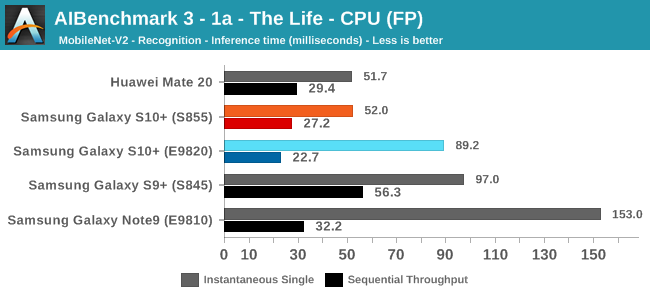
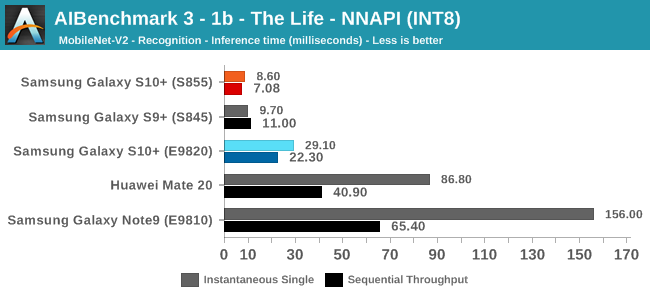
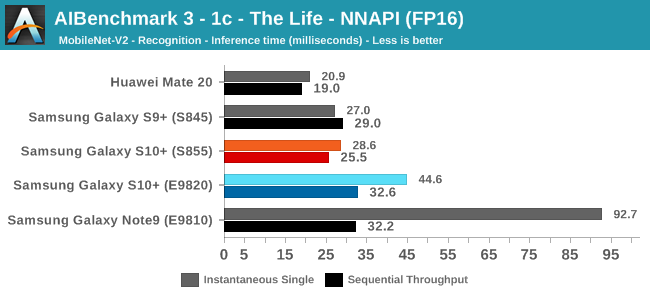

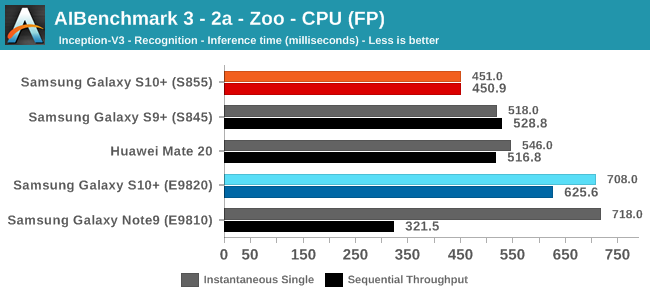
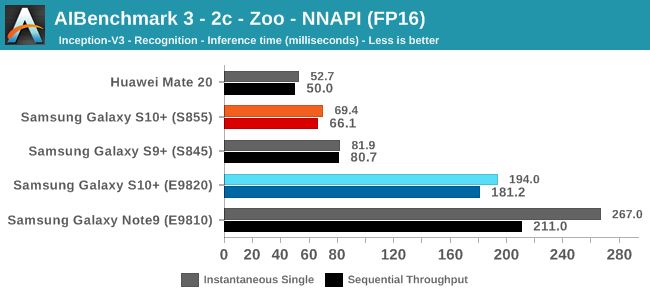
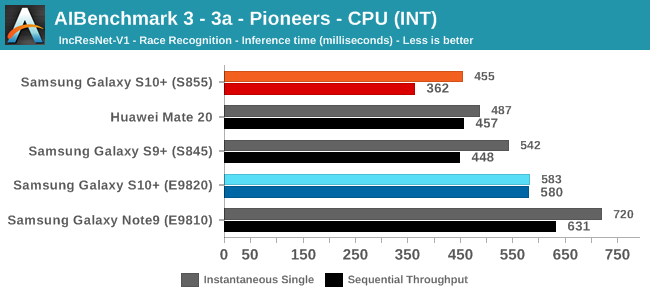
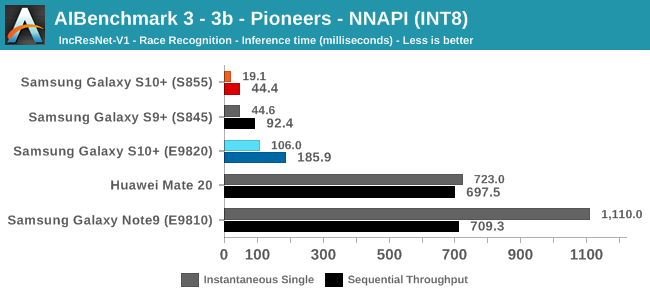
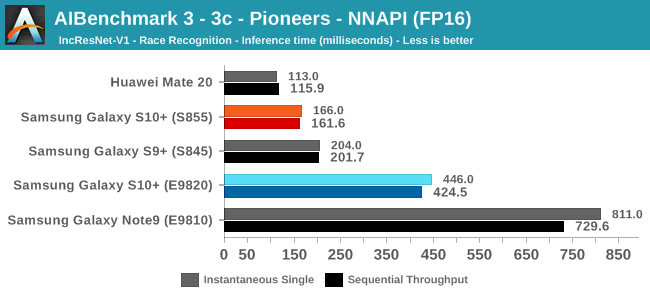

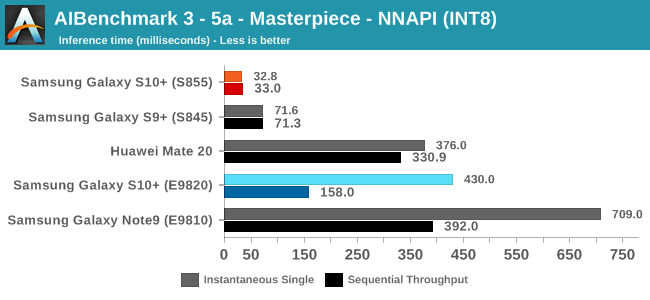
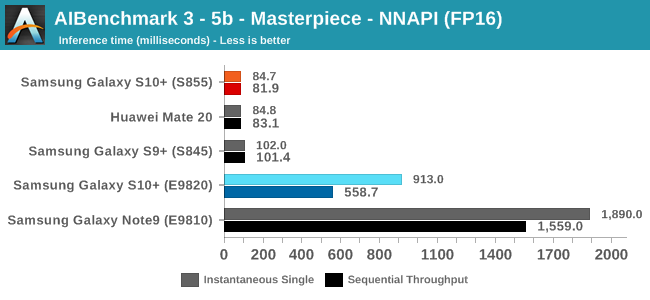
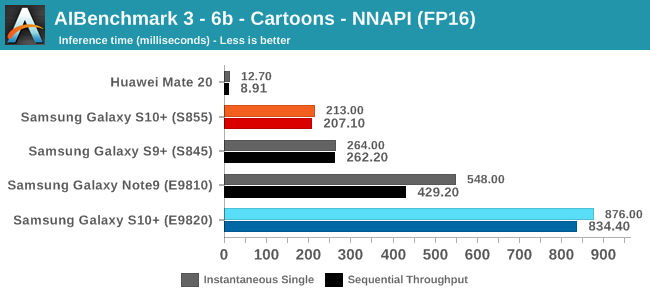






As initially predicted, the results are extremely spread across all the SoCs.
The new tests also include workloads that are solely using TensorFlow libraries on the CPU, so the results not only showcase NNAPI accelerator offloading but can also serve as a CPU benchmark.
In the CPU-only tests, we see the Snapdragon 855 and Exynos 9820 being in the lead, however there’s a notable difference between the two when it comes to their instantaneous vs sequential performance. The Snapdragon 855 is able to post significantly better single inference figures than the Exynos, although the latter catches up in longer duration workloads. Inherently this is a software characteristic difference between the two chips as although Samsung has improved scheduler responsiveness in the new chip, it still lags behind the Qualcomm variant.
In INT8 workloads there is no contest as Qualcomm is far ahead of the competition in NNAPI benchmarks simply due to the fact that they’re the only vendor being able to offload this to an actual accelerator. Samsung’s Exynos 9820 performance here actually has also drastically improved thanks to the new Mali G76’s new INT8 dot-product instructions. It’s odd that the same GPU in the Kirin 980 doesn’t show the same improvements, which could be due to not up-to-date Arm GPU NNAPI drives on the Mate 20.
The FP16 performance crown many times goes to the Kirin 980 NPU, but in some workloads it seems as if they fall back to the GPU, and in those cases Qualcomm’s GPU clearly has the lead.
Finally for FP32 workloads it’s again the Qualcomm GPU which takes an undisputed lead in performance.
Overall, machine inferencing performance today is an absolute mess. In all the chaos though Qualcomm seems to be the only SoC supplier that is able to deliver consistently good performance, and its software stack is clearly the best. Things will evolve over the coming months, and it will be interesting to see what Samsung will be able to achieve in regards to their custom SDK and NNAPI for the Exynos NPU, but much like Huawei’s Kirin NPU it’s all just marketing until we actually see the software deliver on the hardware capabilities, something which may take longer than the actual first year active lifespan of the new hardware.










229 Comments
View All Comments
Andrei Frumusanu - Monday, April 1, 2019 - link
I have a larger scale article on this topic in the coming months.Wardrive86 - Monday, April 1, 2019 - link
Look forward to that!s.yu - Monday, April 1, 2019 - link
"HDR10 non plus"lol
That looks like French.
JTBM_real - Monday, April 1, 2019 - link
Samsung Galaxy S7 Edge - It is usable now. At the start the phone part did not work - it froze after a few hours and you did not receive calls and couldnt call anyone. Software issue. Headphone had an unbearable noise - software issue. Edge screen made it impossible to use it with one hand - could not receive a call in my car. Restart took ages and had to restart every few hours. There were other issues too. By today the phone is actually ok. There is a new sh*t on it "Smartthings running" - I don't care, just not show on the screen.I will never buy a new Samsung phone ever again. It is unusable in the first 2 years. The hardware is good though. No scratch until today. Huwai had two large ones after 1 week - my wife bought one. It had on paper the same gorilla glass as my phone. Yeah...
twinuser01 - Monday, April 1, 2019 - link
Would an unlocked device from the US or Canada work in the EU (Germany)?Andrei Frumusanu - Monday, April 1, 2019 - link
Yes it would, although things like VoLTE or WiFi calling will not.nuttyprof1991 - Monday, April 1, 2019 - link
Hi guys,I noticed a weird effect related to the gamma.
So I installed the app called display tester from play store and ran the gamma test.
During the test i found he gamma values to be very low and found it a bit strange.Then again I checked after one day and noticed it was around 2.2 most of the time.
During both the tests the only difference I noticed in my setting was the resolution which affected the tests soo much. Is this possible? The accuracy was perfect in max resolution of 3040 by 1440.
Andrei Frumusanu - Monday, April 1, 2019 - link
The visual gamma testers such as that app rely on correct 1:1 pixel mapping for the display panel and the comparison background interleaved pattern in the app, on smartphones this is hard to achieve due to how things are resolution independent. The app will not work correctly on pentile display nor will it work correctly in the resolution change scenario you describe.nuttyprof1991 - Monday, April 1, 2019 - link
that makes sense. I was wondering if this could have resulted in the gamma problems explained in the review. Guess notagn53 - Monday, April 1, 2019 - link
Unless I'm missing something, I don't see anything related with phone quality and performance (call stability and sound, signal strength, network speed, quality and range) or the UI (aesthetics and ergonomics, speed and load, functionality) or even health related and other features.Isn't phone usage and graphical design a important requisite for this type of tech?...
It's a phone, after all. But nevertheless a very comprehensive and factual review, almost perfect but yet so flawed ... :-)